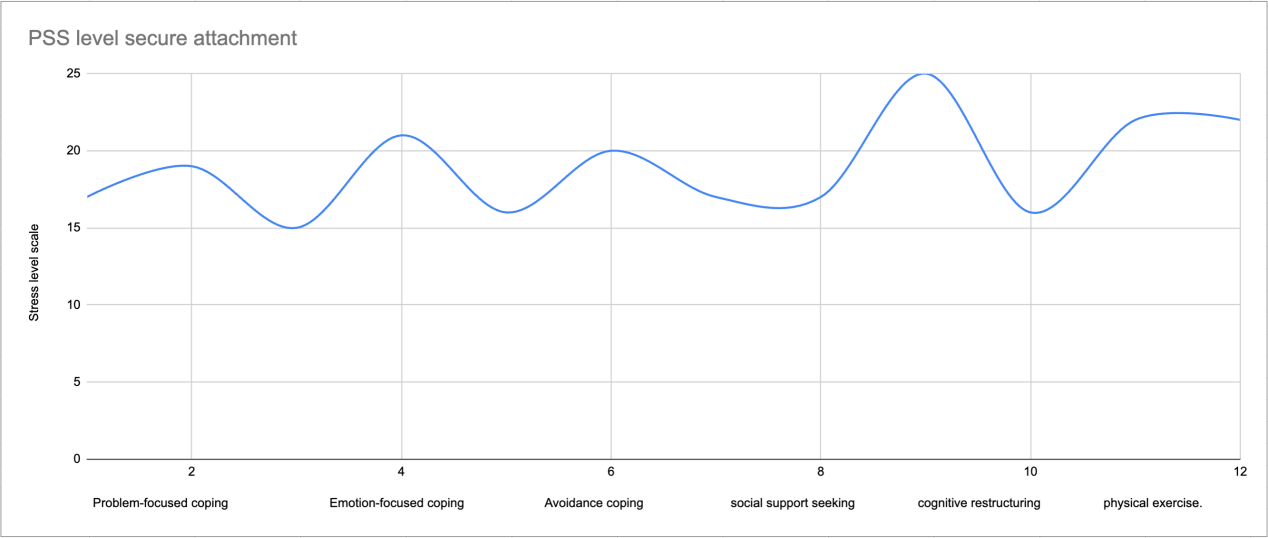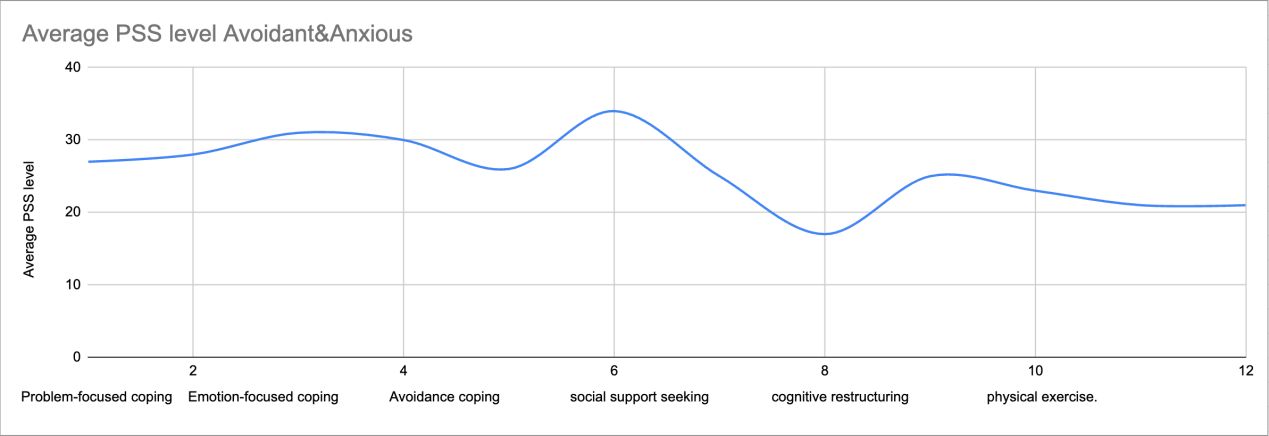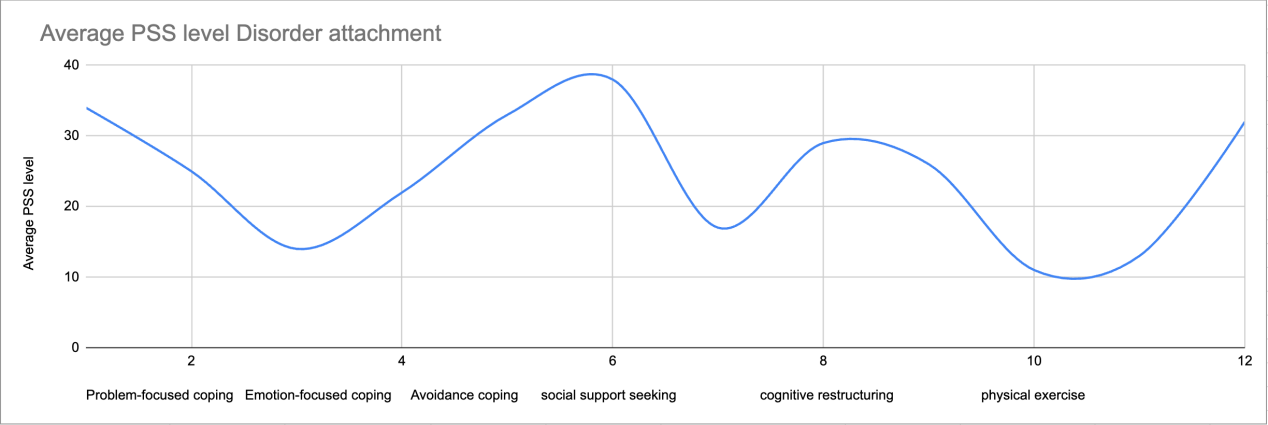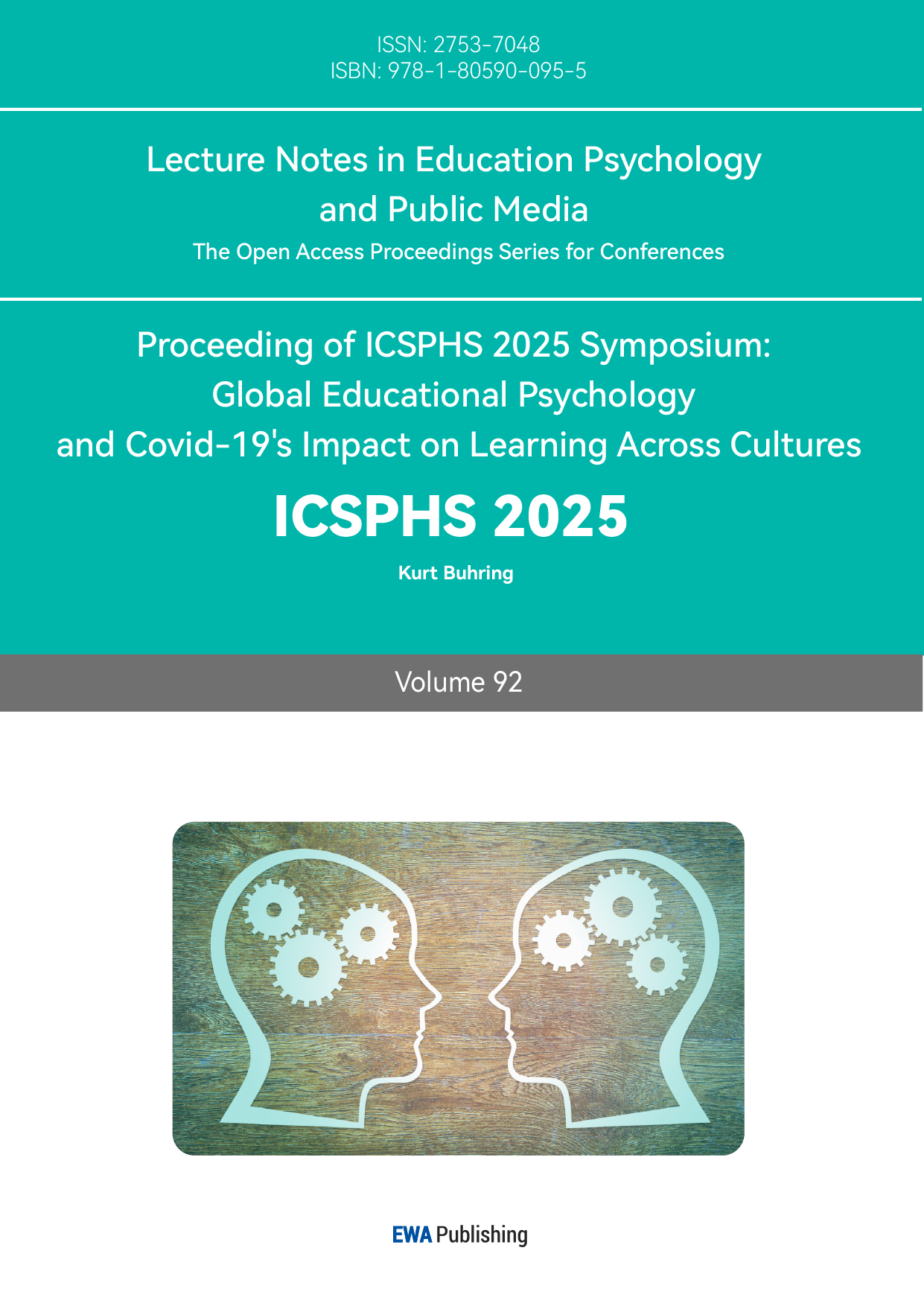1. Introduction
Although stress can contribute to motivation and academic work, excessive stress has been proven to have an negative impact on mental wellness and academic performance in young adults. And individuals cope and interact with this stress is often determined by many factors, the most crucial being one’s personality and attachment style. In previous researches, such as the study by Cooper, Shaver, and Collins, titled Attachment Styles, Emotion Regulation, and Adjustment in Adolescence [1], has demonstrated a significant link between attachment styles and emotional regulation in young adults. This study shows that attachment styles play an important role in the effectiveness of psychological adjustments. Although showing in how attachment styles affect an individuals perception and gain stress the previous study does not explore how attachment styles impact coping of stress. This gap in the information given emphasizes how crucial it is to look into the relationship between attachment patterns and coping strategy effectiveness in an academic setting.
2. Present work
The primary aim of this study is to explore and potentially explain the relationship between attachment styles and the efficiency of coping mechanisms in managing academic stress among teenagers and young adults. By looking at surveys answered by controlled groups and variables of coping mechanisms on h securely, anxiously, avoidant, and disorganized attached individuals respond to academic stress, this study seeks to identify patterns in coping strategies such as Problem-focused coping, Emotion-focused coping, Avoidance coping social support seeking, cognitive restructuring and physical exercise. Using a sample of 100 participants aged 14-22, we will measure perceived stress levels monthly using the Perceived Stress Scale (PSS) [2]and assess attachment styles through a standardized questionnaire. The goal is to eventually understand how an individual’s role in relationships and personality influences the adaptability and effectiveness of coping mechanisms over time.
3. Study 1
3.1. Method
We will report all measures, manipulations, and exclusions. This study will be approved by and carried out in accordance with the recommendations of the Institutional Review Board for human participants with written informed consent obtained from all participants.
Participants. 100 individuals will be recruited to participate.
We hope to recruit 100 total participants (50 females; M=50 years, SD=1.41). 25 for each attachment style: Secure, Anxious, Avoidant, Disorder
Our primary hypothesis involves assessing …. We performed a power analysis using the software package G*Power. The results indicated that with N=100, our experiment could detect an effect size of Cohen’s d of 0.5, using a paired t-test at a 5% alpha level (two-tailed) threshold with 80% statistical power.
3.2. Study design
The study will recruit 100 participants form ages 14-22, with equal amounts of each attachment style (25 participants per category: secure, anxious, avoidant, and disorganized). Participants will be recruited from local high schools, colleges, and universities, ensuring a diverse sample that can represent the target population. Students will complete a survey ASQ indicating their attachment style and 25 of each will be selected to participate in this study.
3.3. Procedures
In order to recruit equal amounts of participants for each style a standardized self-report attachment style questionnaire will be completed by students, such as the Experiences in Close Relationships-Revised (ECR-R) or Attachment Style Questionnaire (ASQ). This will classify the participants’ four attachment style categories. Participants will then complete the PSS survey on a monthly basis, 5 individuals from each attachment style group will remain as the controlled group and will not participant in any active form of coping. For the other 80% of the participants every two months they will switch between the following active coping mechanisms Problem-focused coping, Emotion-focused coping, Avoidance coping, social support seeking, cognitive restructuring and physical exercise. The rest of the participants will not actively participate in any off these coping mechanisms, this will show the effectiveness of the coping mechanisms rather than just the efficiency.
Measure 1.
Attachment Style Questionnaire (ASQ)
This questionnaire will determine the attachment style of the participants.
Measure 2.
Perceived Stress Scale (PSS)
This scale will determine the general stress level of the participants. The PSS level is measured from a range of 0-40 Scores ranging from 0-13 would be considered low stress. Scores ranging from 14-26 would be considered moderate stress. Scores ranging from 27-40 would be considered high perceived stress.
4. Results
Aim 1. We predicted that the Secured group will have a lower stress level in general regardless of coping mechanisms over the 12 months. This is because they generally receive less stress from the same events compared to other attachments styles, and we believe that they’re coping efficiency is higher than the other participants groups See Figure 1.
Aim 2. We predicted that the Anxious and avoidant group will have a generally high stress level through out the year due to how participants generally receive and cope with stress. Hence we believe that these two groups of participants will have a lower efficiency regarding coping with academic stress, See figure 2
Aim 3. we predicted that participants that are disorderly attached will not show a specific trend in stress levels, we believe that the data collect will not be high or low compared to the other groups. This is because of how the disorderly attached participants tend to have unstable characteristics in relationships also causing the efficiency of coping unstable. See figure 3
5. General discussion
The general aim of this research was to examine the relation between personality and stress treatment among teenagers. As one of the major sources of stress academics has always casted a great impact on young adult’s mental health. This study explores the cause and potential solution of academic stress. WE expected to find that securely attached young adults tend to cope better with the same coping mechanisms when it comes to academic stress. The present work plan is to recruit 100 participants (aged 14-22) equally representing secure, anxious, avoidant, and disorganized attachment styles. The attachment styles of participants is determined by ASQ (attachment style questionnaire), and the stress level is determined by the PSS scale. Participants will complete this survey on a monthly basis over the course of a year. 80% of the participants will switch between 6 coping mechanisms, 20% will remain as control groups. We then summarize the average stress levels of each group determine the effectiveness of coping mechanisms. Our expected results are that securely attached participants have a sighing coping efficiency with stable, adaptive strategies and in general. We believe that this is because they tend to be more emotionally stable hence being less likely to accumulate stress and cope with it. For anxious and avoidant participants we predicted that they will have a higher average in stress levels throughout the year disregarding the coping mechanism. This is because they tend to build up and receive stress from academics more easily [3]. Strengths of this study would be that it does not require much data collection and does not have strict rules when it comes to recruiting participants. We will be able to conduct this study just by sending out surveys, to local high school and college students. Limitations of this study might be that with such a small number of participants there might be unpredictable variables affecting their stress levels as a whole making the results less reliable [4]. Another limitation would be the data collection, as a self-report, surveys cannot always express and reflect the participants feeling or stress in the most accurate way. This study aims to find potential connection between academic stress and personality dynamics, the results can reuse to help educational institutes strengthen their mental health programs and help young adults with stress coping. In conclusion, by identifying this connection through this study, it portrays the importance of considering personality dynamics such as attachment styles in mental health programs [5]. It helps develop the interventions to be more personalized and help students better and assist them to deal with academic pressure and stress they are facing in life. Future research can further expand on these connections, finding more direct relations between personality and mental health of all age groups.
6. Conclusion
In conclusion, Securely attached individuals tends to generally have a high coping efficiency over all of the coping mechanisms being tested. Avoidant and Anxious individuals tend to have a higher stress level compared to the secured group. Lastly disorderly attached individuals show a relatively unstable PSS stress level throughout the experiment. This study highlights the correlation between individual personality and stress levels and the efficiency of common coping mechanisms. Also exploring the potential correlation between stress level and the formation of individual attachment styles.

Figure 1: Average PSS level: secure attachment
The PSS level is measured from a range of 0-40 Figure 1Scores ranging from 0-13 would be considered low stress. Scores ranging from 14-26 would be considered moderate stress. Scores ranging from 27-40 would be considered high perceived stress. Horizontal axis are the coping mechanisms that participants will use during the months above. Blue line indicates the average stress level among the 20 participants over time. The six active coping mechanisms in monthly order are: Problem-focused coping, Emotion-focused coping, Avoidance coping, social support seeking, cognitive restructuring and physical exercise. p < .05

Figure 2: Average PSS level: avoidant & anxious
The PSS level is measured from a range of 0-40 Figure 1Scores ranging from 0-13 would be considered low stress. Scores ranging from 14-26 would be considered moderate stress. Scores ranging from 27-40 would be considered high perceived stress. Horizontal axis are the coping mechanisms that participants will use during the months above. Blue line indicates the average stress level among the 40 participants over time. The six active coping mechanisms in monthly order are: Problem-focused coping, Emotion-focused coping, Avoidance coping, social support seeking, cognitive restructuring and physical exercise. p < .05

Figure 3: Average PSS level: disorder attachment
The PSS level is measured from a range of 0-40 Figure 1Scores ranging from 0-13 would be considered low stress. Scores ranging from 14-26 would be considered moderate stress. Scores ranging from 27-40 would be considered high perceived stress. Horizontal axis are the coping mechanisms that participants will use during the months above. Blue line indicates the average stress level among the 40 participants over time. The six active coping mechanisms in monthly order are: Problem-focused coping, Emotion-focused coping, Avoidance coping, social support seeking, cognitive restructuring and physical exercise. p < .05
References
[1]. Cooper, M. L., Shaver, P. R., & Collins, N. L. (1998). Attachment styles, emotion regulation, and adjustment in adolescence. Journal of Personality and Social Psychology, 74(5), 1380–1397. https://doi.org/10.1037/0022-3514.74.5.1380
[2]. Gillath, O., Shaver, P. R., Baek, J.-M., & Chun, D. S. (2008). Genetic Correlates of Adult Attachment Style. Personality and Social Psychology Bulletin, 34(10), 1396–1405. https://doi.org/10.1177/0146167208321484
[3]. Sepehrian Azar F , Asadi Majreh S , Asadnia S ,et al.THE RELATIONSHIP BETWEEN ATTACHMENT AND COPING STYLES WITH EMOTION DYSREGULATION IN ADOLESCENCE[J].Urmia Medical Journal, 2014, 25(10):922-930.
[4]. Andresen, Pia K, et al. “How to Measure and Model Personality Traits in Everyday Life: A Qualitative Analysis of 300 Big Five Personality Items.” Journal of Research in Personality, vol. 112, no. 0092-6566, 1 Aug. 2024, pp. 104528–104528, https://doi.org/10.1016/j.jrp.2024.104528.
[5]. Peeters, Margot, et al. “Understanding and Tackling Academic Stress and School Attendance Problems within the School System; a Co-Creation Approach.” Mental Health & Prevention, vol. 37, no. 2212-6570, 16 Dec. 2024, p. 200388, www.sciencedirect.com/science/article/abs/pii/S2212657024000709, https://doi.org/10.1016/ j.mhp.2024.200388.
Cite this article
Liao,J. (2025). Attachment Styles and Coping Efficiency: Navigating Academic Stress. Lecture Notes in Education Psychology and Public Media,92,107-112.
Data availability
The datasets used and/or analyzed during the current study will be available from the authors upon reasonable request.
Disclaimer/Publisher's Note
The statements, opinions and data contained in all publications are solely those of the individual author(s) and contributor(s) and not of EWA Publishing and/or the editor(s). EWA Publishing and/or the editor(s) disclaim responsibility for any injury to people or property resulting from any ideas, methods, instructions or products referred to in the content.
About volume
Volume title: Proceedings of the 3rd International Conference on Social Psychology and Humanity Studies
© 2024 by the author(s). Licensee EWA Publishing, Oxford, UK. This article is an open access article distributed under the terms and
conditions of the Creative Commons Attribution (CC BY) license. Authors who
publish this series agree to the following terms:
1. Authors retain copyright and grant the series right of first publication with the work simultaneously licensed under a Creative Commons
Attribution License that allows others to share the work with an acknowledgment of the work's authorship and initial publication in this
series.
2. Authors are able to enter into separate, additional contractual arrangements for the non-exclusive distribution of the series's published
version of the work (e.g., post it to an institutional repository or publish it in a book), with an acknowledgment of its initial
publication in this series.
3. Authors are permitted and encouraged to post their work online (e.g., in institutional repositories or on their website) prior to and
during the submission process, as it can lead to productive exchanges, as well as earlier and greater citation of published work (See
Open access policy for details).
References
[1]. Cooper, M. L., Shaver, P. R., & Collins, N. L. (1998). Attachment styles, emotion regulation, and adjustment in adolescence. Journal of Personality and Social Psychology, 74(5), 1380–1397. https://doi.org/10.1037/0022-3514.74.5.1380
[2]. Gillath, O., Shaver, P. R., Baek, J.-M., & Chun, D. S. (2008). Genetic Correlates of Adult Attachment Style. Personality and Social Psychology Bulletin, 34(10), 1396–1405. https://doi.org/10.1177/0146167208321484
[3]. Sepehrian Azar F , Asadi Majreh S , Asadnia S ,et al.THE RELATIONSHIP BETWEEN ATTACHMENT AND COPING STYLES WITH EMOTION DYSREGULATION IN ADOLESCENCE[J].Urmia Medical Journal, 2014, 25(10):922-930.
[4]. Andresen, Pia K, et al. “How to Measure and Model Personality Traits in Everyday Life: A Qualitative Analysis of 300 Big Five Personality Items.” Journal of Research in Personality, vol. 112, no. 0092-6566, 1 Aug. 2024, pp. 104528–104528, https://doi.org/10.1016/j.jrp.2024.104528.
[5]. Peeters, Margot, et al. “Understanding and Tackling Academic Stress and School Attendance Problems within the School System; a Co-Creation Approach.” Mental Health & Prevention, vol. 37, no. 2212-6570, 16 Dec. 2024, p. 200388, www.sciencedirect.com/science/article/abs/pii/S2212657024000709, https://doi.org/10.1016/ j.mhp.2024.200388.









